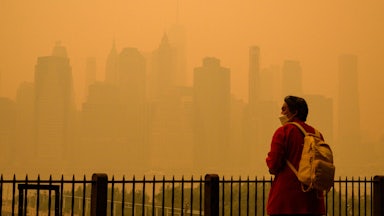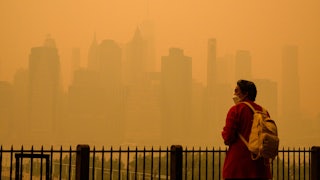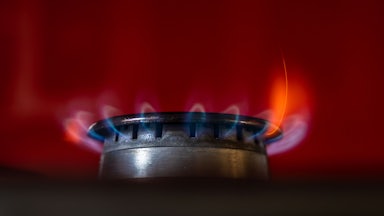The climate crisis once appeared confined to the great outdoors: rising oceans, bracing wildfires, and surging temperatures. So too were the most obvious signs of broader environmental degradation, like lead in the river, plastics in the ocean, and smog in the atmosphere.
But these days, the call is coming from inside the house. Indoor air pollution—and its myriad human health effects—is a pressing public health issue, experts declared in a commentary in the journal Nature earlier this year.
Those who have faced wildfire smoke, or urban smog, likely know the basics of the air quality index, or AQI, which tracks local concentrations of outdoor air pollution, particularly ground-level ozone and particulate matter. It runs from green/good (0–50) to maroon/hazardous (301 and up). Cities tend to cycle, up and down and up again, depending on the season; on occasion, Delhi, one of the world’s most polluted cities, passes an AQI of 900—the equivalent of smoking 50 cigarettes a day. At such heights, poor air quality can exacerbate asthma, lead to myriad other heart and lung issues, and even damage the brain. It also contributes to about seven million premature deaths globally, according to the World Health Organization.
Indoor air quality, or IAQ, by contrast, has been overlooked by researchers, policymakers, and the lay public alike. In the past, scientists have focused more on the environmental threats they can see, like urban smog or visibly contaminated waters. Sixty years after the Clean Air Act regulated pollution outdoors, neither state nor federal legislators have even seriously attempted to control indoor air quality. And the most obvious interventions, like air filters, are inaccessible to millions of cash-strapped tenants.
Yet the available data paints a troubling picture: Indoor spaces contain, on average, higher concentrations of pollution than outdoor air in communities across the United States. “It is the vast majority of our exposure,” Dustin Poppendieck, an environmental engineer in the indoor air quality and ventilation group at the National Institute of Standards and Technology, told me.
Indoor air quality can spike in response to outdoor contaminants, which infiltrate buildings in myriad ways, from mechanical ventilation systems to various nooks and crannies. But indoor air pollution is also generated internally, by combustion appliances such as gas stoves and the process of cooking itself; by chemicals used in building supplies and furniture manufacturing; by excess moisture, which can lead to mold; and even by hair spray and dry shampoo. Just running the vacuum can cause the IAQ to fluctuate.
Unlike its outdoor counterpart, indoor air pollution does not have an obvious color-coded scale of severity, and the AQI cannot be easily translated to our homes, schools, or office buildings. “Even though we know outdoor air chemistry well,” Poppendieck said, “we’re still learning about indoor air chemistry.”
That’s largely because our indoor environments are actually vastly more complex than air flow in the great outdoors. A single building can be home to thousands of different chemicals, each in different quantities, and each in different zones (think: kitchen versus bathroom versus bedroom), making it challenging to scope the hazards overall. While researchers are now working to quantify the cumulative effects of these materials, they’ve got an uphill battle ahead.
Even if there were a handy guide for indoor air pollution, almost no one would be able to apply it to their lives today. Mary Prunicki, director of air pollution and health research at Stanford University’s Sean N. Parker Center for Allergy and Asthma Research, told The City earlier this month that she keeps multiple air monitors running in rooms throughout her home. (“I have a monitor in my daughter’s room, and I knew when she was using hair spray—it would spike,” she said.) But most people have no means—or, until recently, any interest—in tracking the quality of the air inside their homes. Right now, consumer-grade air quality sensors can easily run $300 a unit, and they don’t always offer the most reliable data. And if people don’t know how to act on the data they generate, the sensor is fairly meaningless.
Americans spend about 90 percent of their lives indoors—and the climate crisis and other environmental threats have only pushed us deeper into our homes. On a clear day, people can (and perhaps should) open their windows to air a room out. But when wildfire smoke from Canada blanketed the Eastern seaboard in early June, those who could understandably chose to cloister at home, rather than risk inhaling the visibly contaminated air outside. In New York City, the AQI hit 484—reportedly the highest ever recorded in the city—but millions of New Yorkers’ at-home IAQ levels were never considered. “Sometimes, just staying indoors and closing windows—if you’re in a housing situation that doesn’t have healthy indoor air quality or good ventilation—could actually be worse for you,” Ana Baptista, an associate professor of environmental policy at the New School, recently told Yessenia Funes in this magazine.
The same paradox—to stay in or go out—is plaguing summertime hikers and outdoor runners. When wildfire smoke, or another environmental health threat, is passing through town, do you hop on an elliptical, either at home or in a gym with unknown air quality? These trade-offs were perhaps most obvious at the height of Covid: When an airborne disease is circulating, how can you safely hunker down in a space with poor ventilation? Now we’re all faced with the increasingly routine question: Hunker down, or venture out?
In the absence of the data people need to answer these questions in their daily lives, Poppendieck says we can still adopt four general strategies for improving indoor air quality: Limit sources of pollution, improve ventilation, remove particles, and control moisture. While I’ve written critically of self-optimization in the face of environmental disasters before, many of these changes can and should be done by individuals, in the spaces they live in now. In the future, IAQ-informed processes can and should be scaled up and incorporated into urban design and engineering.
To limit sources of pollution, municipalities must demand property developers use electric appliances in new constructions, as a New York State law will soon require. They should also incentivize homeowners and landlords to replace existing gas stoves in older units. While the slow move away from gas has generated hysteria among a vocal minority—and has become a popular Republican talking point in recent months—the health benefits of switching to an electric stovetop are real and shouldn’t be sacrificed to a pointless culture war. Going forward, policymakers must also proactively ensure every home cook has an operational range hood—and ideally one that does not filter air but actively shunts it outdoors. The kitchen, it seems, must be the first to change.
To remove particles as they accumulate, residents can invest in smaller HEPA filters, which work by trapping small particles that otherwise float in the air—or get stuck in your lungs. These devices can be ordered online and plugged into any conventional outlet. The key is getting the right number for a given space (easily identified using a handy online calculator and roughly amounting to about two-thirds a clean air delivery rate, or CADR, per square foot) at the right price. Currently, these devices can easily cost hundreds of dollars—a prohibitive fee for many families. Given air quality is often worse in poor communities, municipalities must see to it that these filtration devices, as well as their replacement parts, are available heavily subsidized if not outright free.
In the future, new buildings can also be designed with low-emission materials like stone and oriented on the site for maximum airflow. They can also be constructed with air filtration systems, like industrial-scale HEPA filters. (Notably, these changes might also help to suppress the transmission of airborne diseases, like Covid-19.) Regulations on chemical usage in manufacturing furniture, upholstery, and more will also help to reduce the burden of the built environment on our lungs.
Even as we name and respond to the risks posed by poor indoor air quality, paranoia is not an option. Indoor air pollution poses a problem for many people, but it is not exactly a crisis and can improve with steady systematic change. What’s more, people don’t need to track their every move on a home air quality monitor to know they’d probably be better off if they worked toward replacing their stove, remembering to run the exhaust hood over their oven, and changing the filters inside their HEPA devices on a regular basis.
Even though the threat of poor indoor air quality lurks, in meaningful ways, inside our home, we must remember that this is a societal issue—and it demands societal solutions. While it might be appealing to hunker down in a panic room, alone with your HEPA filters, the best thing people can do for themselves is get outside and connect with others about the particular IAQ issues affecting their community. That’s where breathing better begins.










